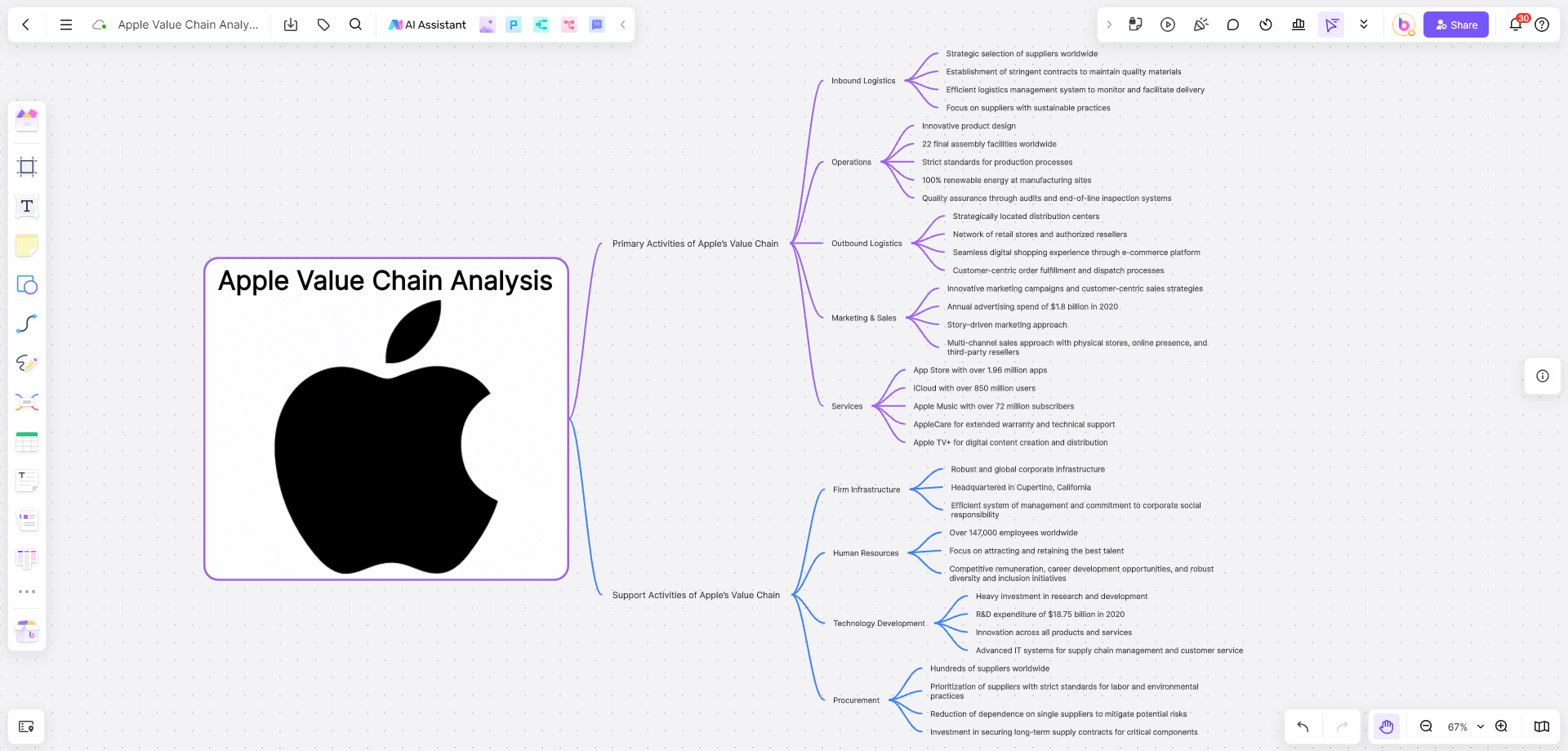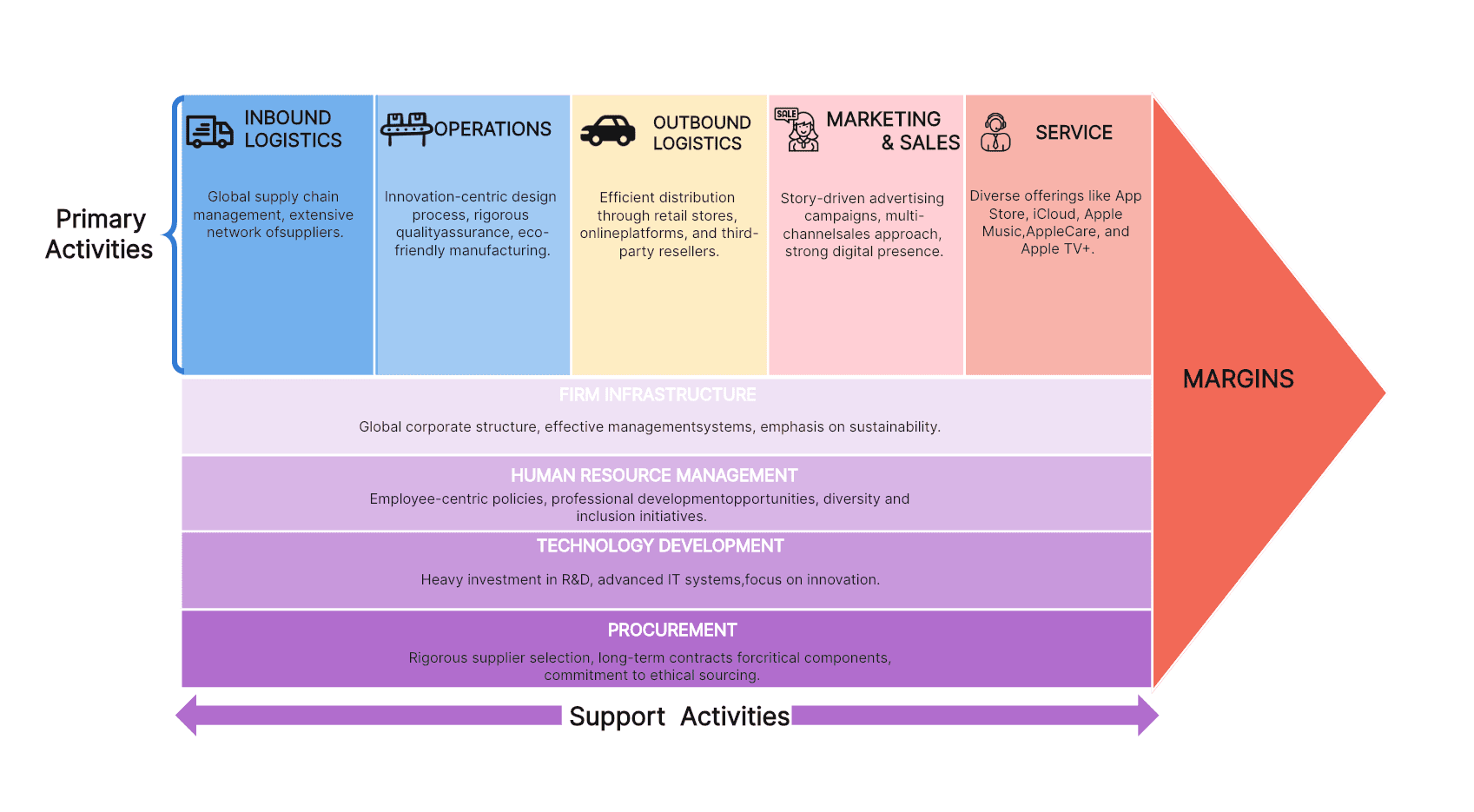Understanding the intricate workings of Apple’s value chain can unlock profound insights into the company's success. This comprehensive analysis delves into the mechanics behind one of the world's most successful corporations. From procurement to technology development, we will reveal how each element of Apple’s value chain contributes to its overall growth and sustainability.

Primary Activities of Apple’s Value Chain
Inbound Logistics
At the outset of Apple's value chain, inbound logistics plays a critical role in ensuring the company's products meet the high-quality standards its customers expect. This process commences with the strategic selection of suppliers worldwide. Suppliers are handpicked based on their ability to consistently provide high-grade materials and components that adhere to Apple's exacting specifications.
Upon selection, the establishment of stringent contracts ensures these suppliers maintain a steady flow of quality materials for Apple's production lines. These partnerships, built on mutual respect and shared standards, ensure Apple's manufacturing processes run smoothly and efficiently.
Simultaneously, an efficient logistics management system is put in place to monitor and facilitate the delivery of these components from suppliers to Apple's manufacturing units. State-of-the-art warehousing facilities ensure materials are stored appropriately to prevent any degradation in quality before entering the production process.
To minimize environmental impact, Apple prioritizes suppliers who adopt sustainable practices. This includes considerations such as energy efficiency and waste reduction in their operations. Such a holistic approach to inbound logistics not only ensures efficiency and quality but also reinforces Apple's commitment to social responsibility.
Operations
Apple's operational strategies stand as a beacon of innovation, reflecting a robust commitment to delivering an unsurpassed customer experience. It's in the domain of operations that Apple's unique blend of visionary thinking and strategic execution comes to the fore.
Every Apple product begins its life cycle in the imagination of a design team acclaimed for its trailblazing ideas. With over 2,000+ patents attributed to Jonathan Ive, Apple's former Chief Design Officer, the company consistently pushes the boundaries of what's possible.
Post-design, these visionary concepts materialize at Apple's manufacturing units. The company operates 22 final assembly facilities worldwide, staffed by dedicated employees who are uncompromising in their commitment to excellence. These facilities reflect Apple's emphasis on environmental responsibility, with 100% of the electricity used at these sites sourced from renewable energy.
Production processes at Apple are guided by stringent standards, assuring every product is a hallmark of quality. According to Apple's 2020 Environmental Progress Report, they recycled over 81,000 metric tons of electronic waste from 2015 to 2019, underscoring the company’s dedication to minimizing waste and optimizing resource use.
Quality assurance is interwoven into every stage of Apple's operations. In 2020 alone, Apple conducted 1,121 audits across its supply chain to ensure adherence to its performance standards. The company also uses end-of-line inspection systems employing machine learning to identify defects and enhance product quality.
Apple’s pursuit of environmentally friendly operations is also noteworthy. By 2030, the company aims to have a net-zero climate impact across its entire business, including manufacturing processes.
Through precise coordination of design, production, quality control, and sustainable practices, Apple's operations continue to drive its status as a world-class tech innovator.
Outbound Logistics
Apple’s outbound logistics function is a testament to its commitment to providing seamless customer experiences. It is through this channel that Apple’s iconic products journey from their manufacturing facilities to customers around the globe.
Integral to Apple's outbound logistics strategy is its network of strategically located distribution centers. These facilities manage inventory, handle order fulfillment, and ensure the timely dispatch of products. Through advanced inventory management systems and process optimization, Apple ensures that each product arrives at the right place at the right time.
Further extending its reach, Apple leverages a vast network of retail stores - both company-owned and authorized resellers. These retail outlets serve as physical touchpoints where customers can experience Apple’s products firsthand before purchasing. Apple’s retail stores, known for their minimalist design and tech-savvy staff, add a dimension of brand immersion to the customer journey.
For online shoppers, Apple’s e-commerce platform provides a seamless digital shopping experience. From personalized product recommendations to hassle-free checkout processes and quick delivery times, the company's online store mirrors the quality and convenience associated with the Apple brand.
By managing its outbound logistics, Apple exercises tight control over the customer experience post-purchase. This level of oversight allows Apple to maintain its high service standards, drive customer satisfaction, and foster brand loyalty. Whether it's ensuring secure packaging for damage prevention or coordinating timely deliveries, Apple's outbound logistics are designed with an unwavering focus on customer satisfaction.
Marketing & Sales
In the realm of marketing and sales, Apple sets a benchmark. Its iconic campaigns and customer-centric sales strategies have solidified its reputation as an industry leader and fostered an almost fanatical brand loyalty.
Apple's marketing efforts are characteristically innovative, leveraging a mix of traditional media channels and digital platforms. The company's annual advertising spend reflects this commitment to strategic promotion, with expenditure reaching $1.8 billion in 2020.
A significant portion of Apple's marketing is story-driven, often focusing on the users rather than the product. The award-winning "Shot on iPhone" campaign is a prime example, showcasing user-generated photos and videos taken on iPhones. This approach has resonated deeply with consumers, strengthening emotional ties to the brand.
When it comes to sales, Apple utilizes a multi-channel approach. As of 2020, Apple operates 510 retail stores across 25 countries. These stores not only act as sales points but also as hubs for brand immersion and customer support. To complement its physical stores, Apple has also invested heavily in its online presence. With a seamless e-commerce interface and personalized online support, Apple’s digital store drove substantial sales growth in 2020, accounting for an estimated 44% of total U.S. sales.
Furthermore, Apple leverages a broad range of third-party resellers and partners to widen its global reach. Through strategic collaborations with various telecom providers, Apple ensures that its products are accessible even in markets where it doesn't have a direct presence.
Apple's adept handling of marketing and sales has allowed the tech giant to enjoy remarkable success, with total revenue exceeding $274 billion in FY 2020. In the hands of Apple, marketing, and sales are far more than business functions – they are an art form.
Services
Apple's commitment to providing superior user experiences extends far beyond the sale of its products, with the company's suite of services playing an integral role in creating a holistic Apple ecosystem.
Central to this is the App Store, a platform with over 1.96 million apps available for download as of 2021. It serves as a marketplace for developers to reach Apple users, offering everything from games and productivity tools to lifestyle apps and more. Apple's role here isn't just as a platform provider, but also as a gatekeeper ensuring that all apps meet their stringent standards for quality and security.
Another major component is iCloud, Apple's cloud storage service. As of 2020, iCloud had over 850 million users, providing safe and secure storage for photos, files, notes, and more across multiple Apple devices. It also supports other critical functions such as device backup and restore, facilitating a seamless user experience.
Apple Music, with more than 72 million subscribers as of 2020, is Apple's foray into the digital music streaming industry. With its vast music library, exclusive releases, and personalized playlists, it offers a premium listening experience to users.
Not forgetting AppleCare, the company's extended warranty and technical support service. This service demonstrates Apple's commitment to after-sales customer satisfaction, offering customers access to expert technical support and additional hardware service options.
Lastly, the emergence of Apple TV+, the company’s subscription-based streaming service launched in 2019, underscores Apple's expansion into digital content creation and distribution. Despite being a new entrant, Apple TV+ has already made its mark by bagging prestigious awards for its original content.

Support Activities of Apple’s Value Chain
In addition to its primary activities, Apple has a comprehensive range of support activities that reinforce its value chain, ensuring the company maintains its industry-leading position.
Firm Infrastructure
Apple's corporate infrastructure is robust and global in scale. Headquartered in Cupertino, California, in a facility known as Apple Park, the company also has a significant presence across the world. Their efficient system of management, coupled with a commitment to corporate social responsibility and sustainable practices, has helped establish the brand's trust and credibility.
With a workforce of over 147,000 employees worldwide as of 2020, Apple relies on strong leadership and effective human resource management. It emphasizes fostering a culture of innovation and teamwork, enabling it to attract and retain some of the best talent in the industry.
Human Resources
Apple’s human resource strategies have always focused on fostering an innovative and inclusive environment. With over 130,000 employees worldwide, the company emphasizes attracting and retaining the best talent through competitive remuneration, career development opportunities, and robust diversity and inclusion initiatives.
In addition, Apple has invested heavily in employee training and development. The 'Apple University program is an example of this commitment. Established in 2008, it aims to instill Apple’s business culture and values into its employees, ensuring they remain committed to the company's vision of innovation and quality.
Technology Development
As a tech giant, technological development is at the heart of Apple's operations. The company invests heavily in research and development (R&D), with R&D expenditure totaling $18.75 billion in 2020. This investment drives innovation across all of Apple's products and services.
Apple’s technological developments extend beyond its products, with advanced IT systems playing a crucial role in everything from supply chain management to customer service. Sophisticated algorithms power customer recommendations on the App Store and Apple Music, while advanced data analytics enable Apple to monitor performance, track consumer behavior, and forecast trends.
Procurement
Procurement plays a critical role in Apple's value chain. The company works with hundreds of suppliers worldwide to secure the high-quality materials necessary for product manufacturing. In its procurement strategies, Apple prioritizes suppliers that comply with its strict standards for labor and environmental practices.
Notably, Apple strives to reduce its dependence on single suppliers to mitigate potential risks. As part of this strategy, the company invests in securing long-term supply contracts for critical components like flash memory.
Apple Value Chain Analysis Example
Below is a simplified example of Apple's value chain analysis, summarizing these key aspects in a quick-reference format for business professionals:

This model presents an overview of how each segment interconnects and contributes to Apple's success story.
Key Takeaways
Our analysis uncovers the strategic underpinnings of Apple’s value chain. By diligently managing its primary and support activities, Apple has managed to build an exceptionally powerful and resilient brand. Their holistic approach underpins their consistent ability to produce high-quality products and services.
Understanding how Apple’s value chain operates, it’s evident how each activity directly contributes to its unprecedented success. The lessons learned can be valuable for any company wishing to innovate, grow, and maintain a competitive edge in the market.
To conduct your value chain analysis, we recommend using our whiteboard solution, Boardmix. It features a pre-built value chain template to facilitate easy and effective business planning.
Steps to Use Analysis Template on Boardmix
To use this Analysis Template, you can navigate to the workspace of Boardmix, an online whiteboard that provides various free templates. This step-by-step guide will help you use the Analysis template effectively to streamline your drawing process.
Step 1: Log in to Your Boardmix Account
To get started, log into your Boardmix account using your credentials. If you're new to Boardmix, create an account by following their easy sign-up process.

Step 2: Search and Choose Analysis Template
Once you've logged in, navigate to the 'Templates' section available on the platform's main page. Here, you'll find a plethora of ready-to-use templates categorized under various topics, use the search bar for a quicker find.

Step 3: Customize and Edit Your Analysis Template
After selecting the template, it will open in a new Boardmix workspace. Boardmix gives you complete freedom to customize it as per your unique needs. You can:
- Add or delete sections: Click on an existing section and hit the 'Delete' button on your keyboard to remove it. To add new sections or fields, select the 'Text' option from the toolbar and click on the board where you wish to add content.
- Modify text: To edit any text, click on it to open the text box and make your changes.
- Change visual elements: Boardmix allows you to modify colors, fonts, or border styles. These visual elements can be tailored to match your own needs.

Step 4: Save Your Work, Share and Collaborate
Boardmix will save your work online anytime. Once you have customized the template to your satisfaction, you can then share it with other members for collaboration.

Boardmix's collaboration feature allows multiple people to view and edit the feedback form simultaneously in real time. All data is stored safely on Boardmix, making it a reliable tool for maintaining records over time. Get started and try it for free now!













